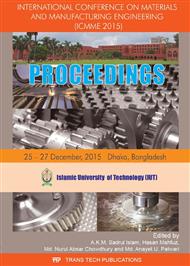p.74
p.81
p.87
p.93
p.99
p.105
p.111
p.117
p.123
Investigation on the Correlation between Structural and Electrical Properties of Lanthanum Doped Barium Titanate Ceramics
Abstract:
The structure-property relationship of 0.3, 0.5 and 0.7mole% lanthanum (La2O3) doped Barium titanate (BaTiO3) ceramics prepared by solid state sintering under different sintering conditions were investigated in this research. The raw materials were La2O3 (grain size=~80nm) and BaTiO3 (grain size=100nm) powders. Field Emission Scanning Electron Microscope (FE-SEM) was used to examine grain size and surface morphology of sintered pellets & X-Ray Diffraction analysis was conducted to identify crystal structure. The results showed significantly improved grain size and electrical properties of BaTiO3 for 0.5 mole% La2O3 with desired grain size (0.8-1.3μm), high densification (>90% theoretical density) and stable dielectric constant (12700) at room temperature (f=100Hz) by lowering curie temperature around 30oC by sintering at 1300oC for 8 hrs. A gradual deterioration follows with increased doping concentration. So the research revealed that proper La3+ concentration can inhibit grain size and lower Curie temperature hence significantly improving the electrical properties of BaTiO3 ceramics.
Info:
Periodical:
Pages:
99-104
Citation:
Online since:
December 2016
Authors:
Price:
Сopyright:
© 2017 Trans Tech Publications Ltd. All Rights Reserved
Share:
Citation:


